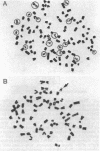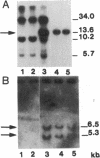Abstract
Complementation of the repair defect in xeroderma pigmentosum cells of complementation group A was achieved by the transfer of human chromosome 9. A set of mouse-human hybrid cell lines, each containing a single Ecogpt-marked human chromosome, was used as a source of donor chromosomes. Chromosome transfer to XPTG-1 cells, a hypoxanthine/guanine phosphoribosyltransferase-deficient mutant of simian virus 40-transformed complementation group A cells, was achieved by microcell fusion and selection for Ecogpt. Chromosome-transfer clones of XPTG-1 cells, each containing a different human donor chromosome, were analyzed for complementation of sensitivity to UV irradiation. Among all the clones, increased levels of resistance to UV was observed only in clones containing chromosome 9. Since our recipient cell line XPTG-1 is hypoxanthine/guanine phosphoribosyltransferase deficient, cultivation of Ecogpt+ clones in medium containing 6-thioguanine permits selection of cells for loss of the marker and, by inference, transferred chromosome 9. Clones isolated for growth in 6-thioguanine, which have lost the Ecogpt-marked chromosome, exhibited a UV-sensitive phenotype, confirming the presence of the repair gene(s) for complementation group A on chromosome 9.
Full text
PDF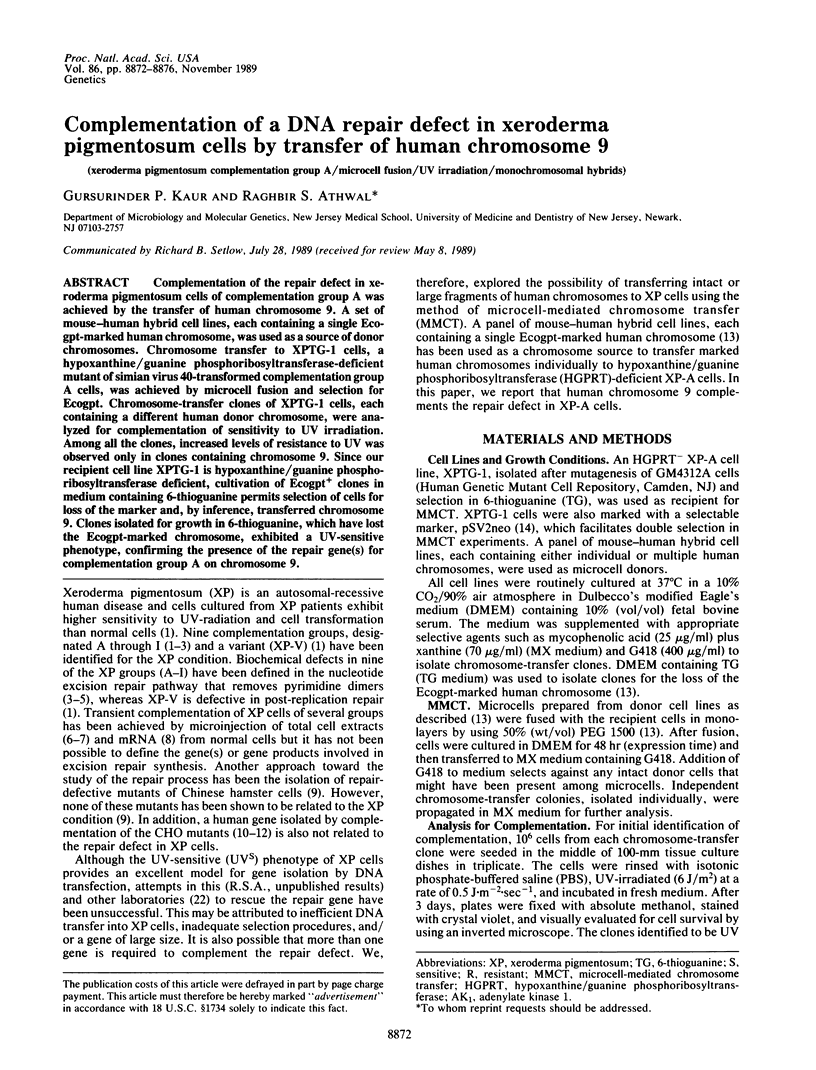
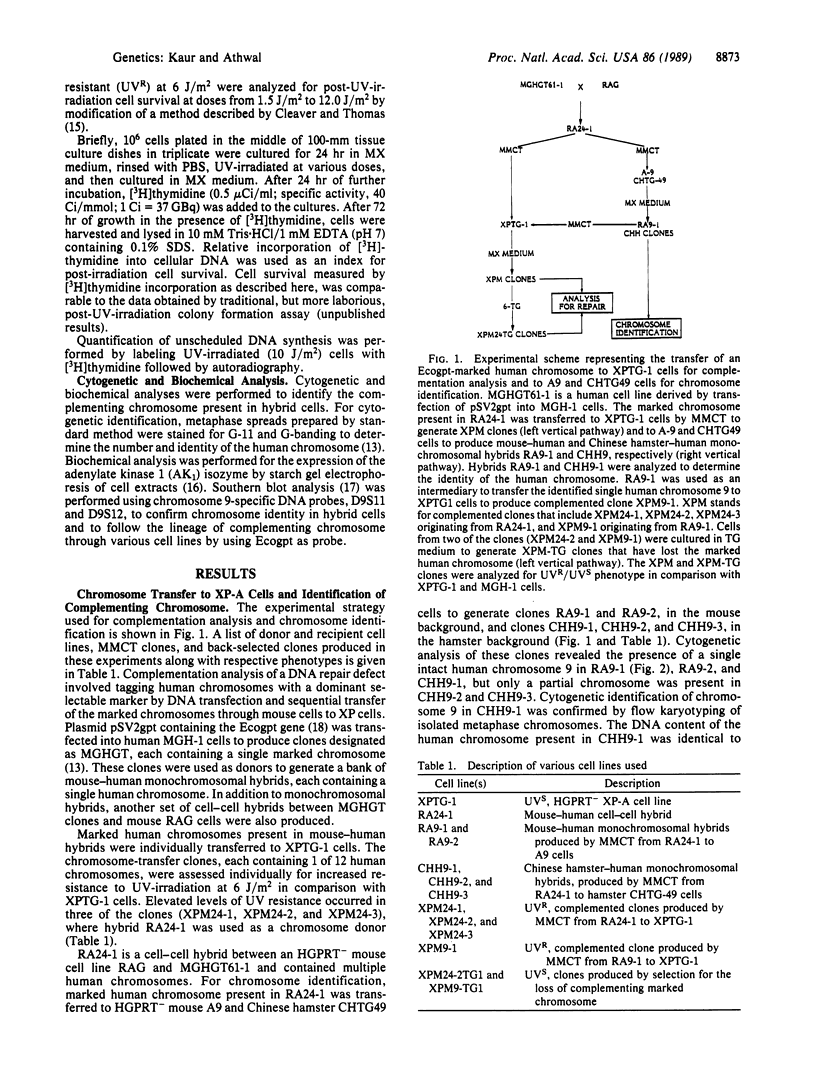
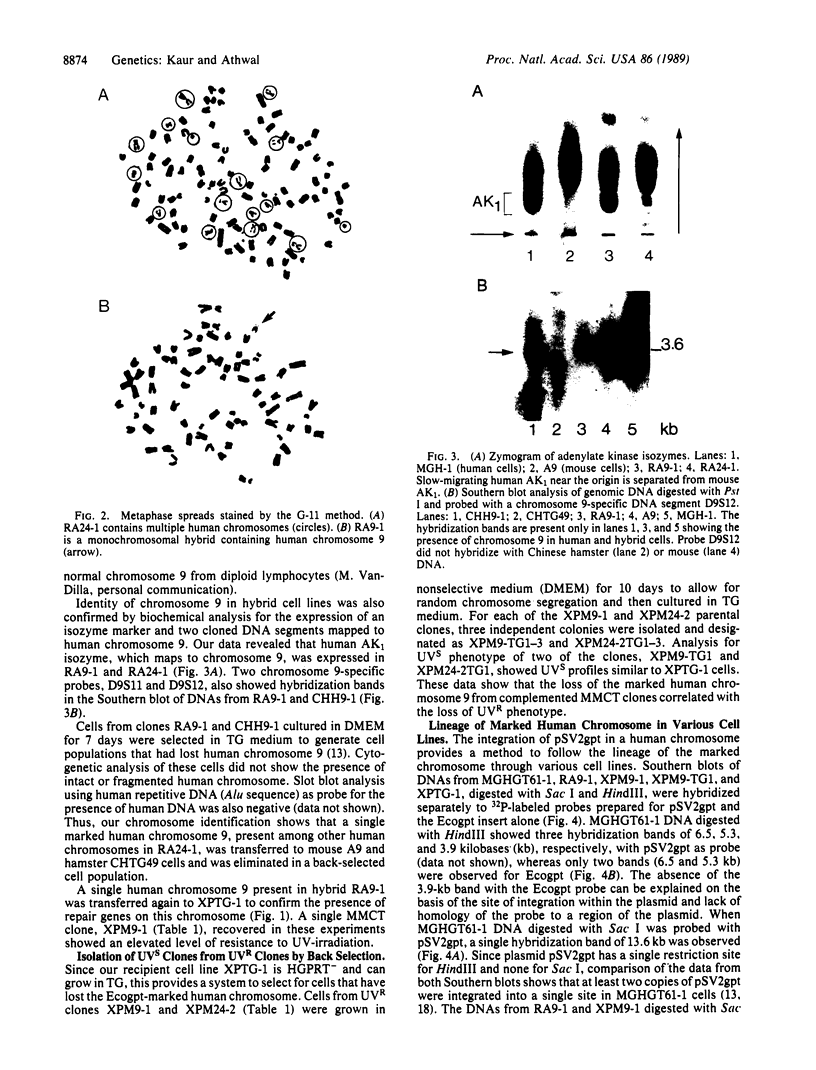
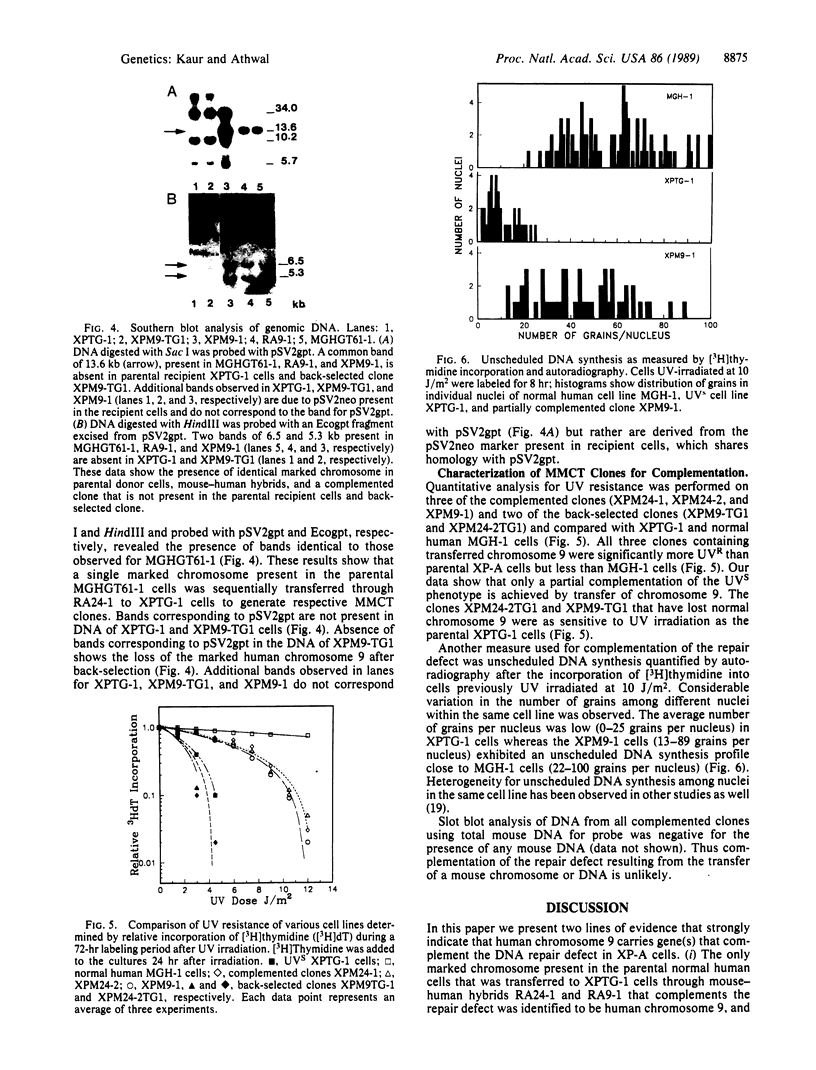
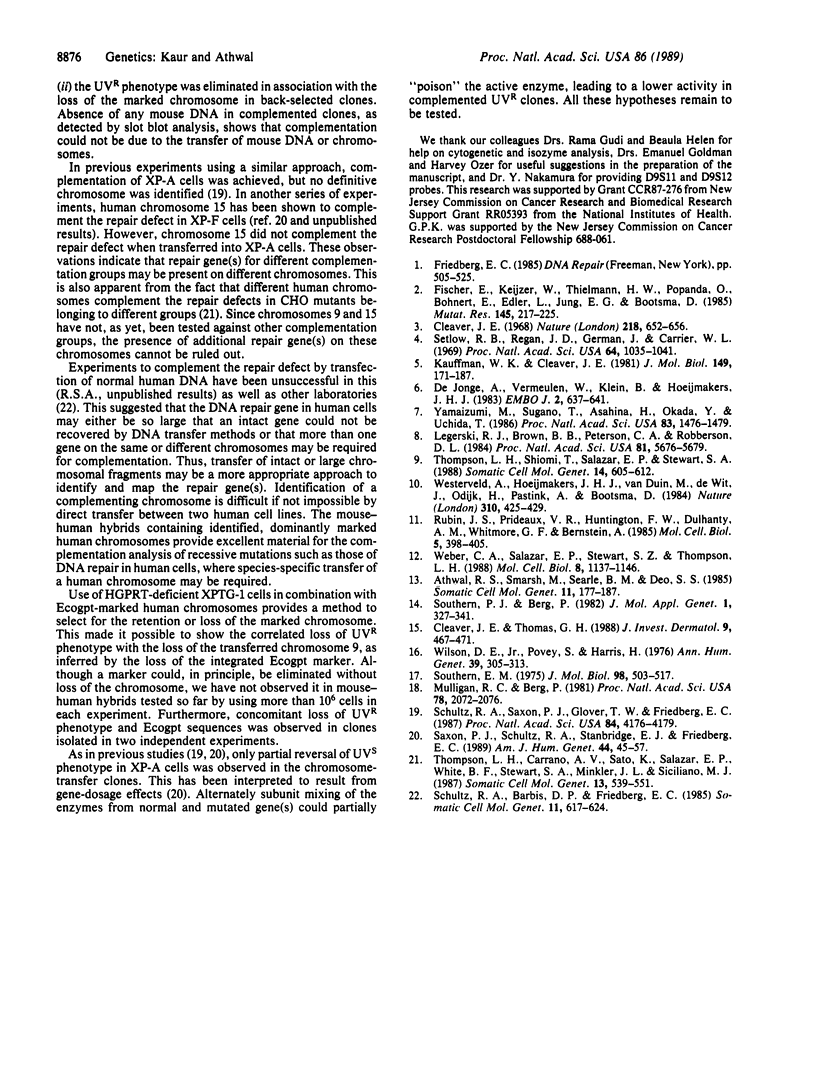
Images in this article
Selected References
These references are in PubMed. This may not be the complete list of references from this article.
- Athwal R. S., Smarsh M., Searle B. M., Deo S. S. Integration of a dominant selectable marker into human chromosomes and transfer of marked chromosomes to mouse cells by microcell fusion. Somat Cell Mol Genet. 1985 Mar;11(2):177–187. doi: 10.1007/BF01534706. [DOI] [PubMed] [Google Scholar]
- Cleaver J. E. Defective repair replication of DNA in xeroderma pigmentosum. Nature. 1968 May 18;218(5142):652–656. doi: 10.1038/218652a0. [DOI] [PubMed] [Google Scholar]
- Cleaver J. E., Thomas G. H. Rapid diagnosis of sensitivity to ultraviolet light in fibroblasts from dermatologic disorders, with particular reference to xeroderma pigmentosum. J Invest Dermatol. 1988 Apr;90(4):467–471. doi: 10.1111/1523-1747.ep12460917. [DOI] [PubMed] [Google Scholar]
- Fischer E., Keijzer W., Thielmann H. W., Popanda O., Bohnert E., Edler L., Jung E. G., Bootsma D. A ninth complementation group in xeroderma pigmentosum, XP I. Mutat Res. 1985 May;145(3):217–225. doi: 10.1016/0167-8817(85)90030-6. [DOI] [PubMed] [Google Scholar]
- Kaufmann W. K., Cleaver J. E. Mechanisms of inhibition of DNA replication by ultraviolet light in normal human and xeroderma pigmentosum fibroblasts. J Mol Biol. 1981 Jun 25;149(2):171–187. doi: 10.1016/0022-2836(81)90297-7. [DOI] [PubMed] [Google Scholar]
- Legerski R. J., Brown D. B., Peterson C. A., Robberson D. L. Transient complementation of xeroderma pigmentosum cells by microinjection of poly(A)+ RNA. Proc Natl Acad Sci U S A. 1984 Sep;81(18):5676–5679. doi: 10.1073/pnas.81.18.5676. [DOI] [PMC free article] [PubMed] [Google Scholar]
- Mulligan R. C., Berg P. Selection for animal cells that express the Escherichia coli gene coding for xanthine-guanine phosphoribosyltransferase. Proc Natl Acad Sci U S A. 1981 Apr;78(4):2072–2076. doi: 10.1073/pnas.78.4.2072. [DOI] [PMC free article] [PubMed] [Google Scholar]
- Rubin J. S., Prideaux V. R., Willard H. F., Dulhanty A. M., Whitmore G. F., Bernstein A. Molecular cloning and chromosomal localization of DNA sequences associated with a human DNA repair gene. Mol Cell Biol. 1985 Feb;5(2):398–405. doi: 10.1128/mcb.5.2.398. [DOI] [PMC free article] [PubMed] [Google Scholar]
- Schultz R. A., Barbis D. P., Friedberg E. C. Studies on gene transfer and reversion to UV resistance in xeroderma pigmentosum cells. Somat Cell Mol Genet. 1985 Nov;11(6):617–624. doi: 10.1007/BF01534726. [DOI] [PubMed] [Google Scholar]
- Schultz R. A., Saxon P. J., Glover T. W., Friedberg E. C. Microcell-mediated transfer of a single human chromosome complements xeroderma pigmentosum group A fibroblasts. Proc Natl Acad Sci U S A. 1987 Jun;84(12):4176–4179. doi: 10.1073/pnas.84.12.4176. [DOI] [PMC free article] [PubMed] [Google Scholar]
- Setlow R. B., Regan J. D., German J., Carrier W. L. Evidence that xeroderma pigmentosum cells do not perform the first step in the repair of ultraviolet damage to their DNA. Proc Natl Acad Sci U S A. 1969 Nov;64(3):1035–1041. doi: 10.1073/pnas.64.3.1035. [DOI] [PMC free article] [PubMed] [Google Scholar]
- Southern E. M. Detection of specific sequences among DNA fragments separated by gel electrophoresis. J Mol Biol. 1975 Nov 5;98(3):503–517. doi: 10.1016/s0022-2836(75)80083-0. [DOI] [PubMed] [Google Scholar]
- Southern P. J., Berg P. Transformation of mammalian cells to antibiotic resistance with a bacterial gene under control of the SV40 early region promoter. J Mol Appl Genet. 1982;1(4):327–341. [PubMed] [Google Scholar]
- Thompson L. H., Carrano A. V., Sato K., Salazar E. P., White B. F., Stewart S. A., Minkler J. L., Siciliano M. J. Identification of nucleotide-excision-repair genes on human chromosomes 2 and 13 by functional complementation in hamster-human hybrids. Somat Cell Mol Genet. 1987 Sep;13(5):539–551. doi: 10.1007/BF01534495. [DOI] [PubMed] [Google Scholar]
- Thompson L. H., Shiomi T., Salazar E. P., Stewart S. A. An eighth complementation group of rodent cells hypersensitive to ultraviolet radiation. Somat Cell Mol Genet. 1988 Nov;14(6):605–612. doi: 10.1007/BF01535314. [DOI] [PubMed] [Google Scholar]
- Weber C. A., Salazar E. P., Stewart S. A., Thompson L. H. Molecular cloning and biological characterization of a human gene, ERCC2, that corrects the nucleotide excision repair defect in CHO UV5 cells. Mol Cell Biol. 1988 Mar;8(3):1137–1146. doi: 10.1128/mcb.8.3.1137. [DOI] [PMC free article] [PubMed] [Google Scholar]
- Westerveld A., Hoeijmakers J. H., van Duin M., de Wit J., Odijk H., Pastink A., Wood R. D., Bootsma D. Molecular cloning of a human DNA repair gene. Nature. 1984 Aug 2;310(5976):425–429. doi: 10.1038/310425a0. [DOI] [PubMed] [Google Scholar]
- Wilson D. E., Povey S., Harris H. Adenylate kinases in man: evidence for a third locus. Ann Hum Genet. 1976 Jan;39(3):305–313. doi: 10.1111/j.1469-1809.1976.tb00134.x. [DOI] [PubMed] [Google Scholar]
- Yamaizumi M., Sugano T., Asahina H., Okada Y., Uchida T. Microinjection of partially purified protein factor restores DNA damage specifically in group A of xeroderma pigmentosum cells. Proc Natl Acad Sci U S A. 1986 Mar;83(5):1476–1479. doi: 10.1073/pnas.83.5.1476. [DOI] [PMC free article] [PubMed] [Google Scholar]
- de Jonge A. J., Vermeulen W., Klein B., Hoeijmakers J. H. Microinjection of human cell extracts corrects xeroderma pigmentosum defect. EMBO J. 1983;2(5):637–641. doi: 10.1002/j.1460-2075.1983.tb01477.x. [DOI] [PMC free article] [PubMed] [Google Scholar]




